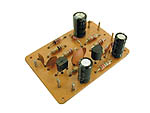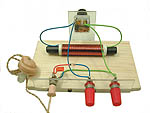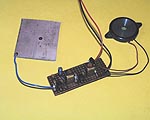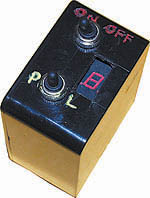
![]() PICRONOS
(Part 1) - A giant-size 250mm diameter LED clock with a difference
- it uses an inner ring of 60 l.e.d.s displaying both seconds and minutes,
an outer ring of 12 l.e.d.s displaying hours, plus an inner zone of 100
l.e.d.s in 7-segment style, giving time, month, days and temperature.
PIC 16F877 based design, mains-adaptor powered, battery backup. Free PICmicro
source code available from our FTP download site. Large p.c.b. aids construction.
PICRONOS
(Part 1) - A giant-size 250mm diameter LED clock with a difference
- it uses an inner ring of 60 l.e.d.s displaying both seconds and minutes,
an outer ring of 12 l.e.d.s displaying hours, plus an inner zone of 100
l.e.d.s in 7-segment style, giving time, month, days and temperature.
PIC 16F877 based design, mains-adaptor powered, battery backup. Free PICmicro
source code available from our FTP download site. Large p.c.b. aids construction.
![]()
 In July
2003 issue (p. 503) we said that Fig. 5, IC5 pins 1 and 9 should be
In July
2003 issue (p. 503) we said that Fig. 5, IC5 pins 1 and 9 should be
connected to the +5V line,not 0V. The p.c.b. is correct.


![]() Practical
Radio Circuits - Part 1. The start of a brand new series introducing
the principles of radio. The series features a variety of practical circuits
for the set builder and experimenter. In Part One we offer an introduction
to radio waves, and suggest three projects for you to build: a simple
crystal set, a single i.c. radio receiver based on the MK484 (was, ZN414),
and a headphone amplifier.
Practical
Radio Circuits - Part 1. The start of a brand new series introducing
the principles of radio. The series features a variety of practical circuits
for the set builder and experimenter. In Part One we offer an introduction
to radio waves, and suggest three projects for you to build: a simple
crystal set, a single i.c. radio receiver based on the MK484 (was, ZN414),
and a headphone amplifier.
This practical series is specially written to dispel the mysteries of radio and will be of interest to novices and experienced constructors everywhere.




![]() "FIDO"
Pedometer. A novel design that keeps track of how far you have walked!
PIC 16F84 design, works in miles or kilometres. Reasonable accuracy of
distance is provided by detecting and counting the number of strides.
It can record the distance traversed and also calculate average speed.
The unit isworn around the left upper calf, and two mercury switches detect
correct leg motion.
"FIDO"
Pedometer. A novel design that keeps track of how far you have walked!
PIC 16F84 design, works in miles or kilometres. Reasonable accuracy of
distance is provided by detecting and counting the number of strides.
It can record the distance traversed and also calculate average speed.
The unit isworn around the left upper calf, and two mercury switches detect
correct leg motion.